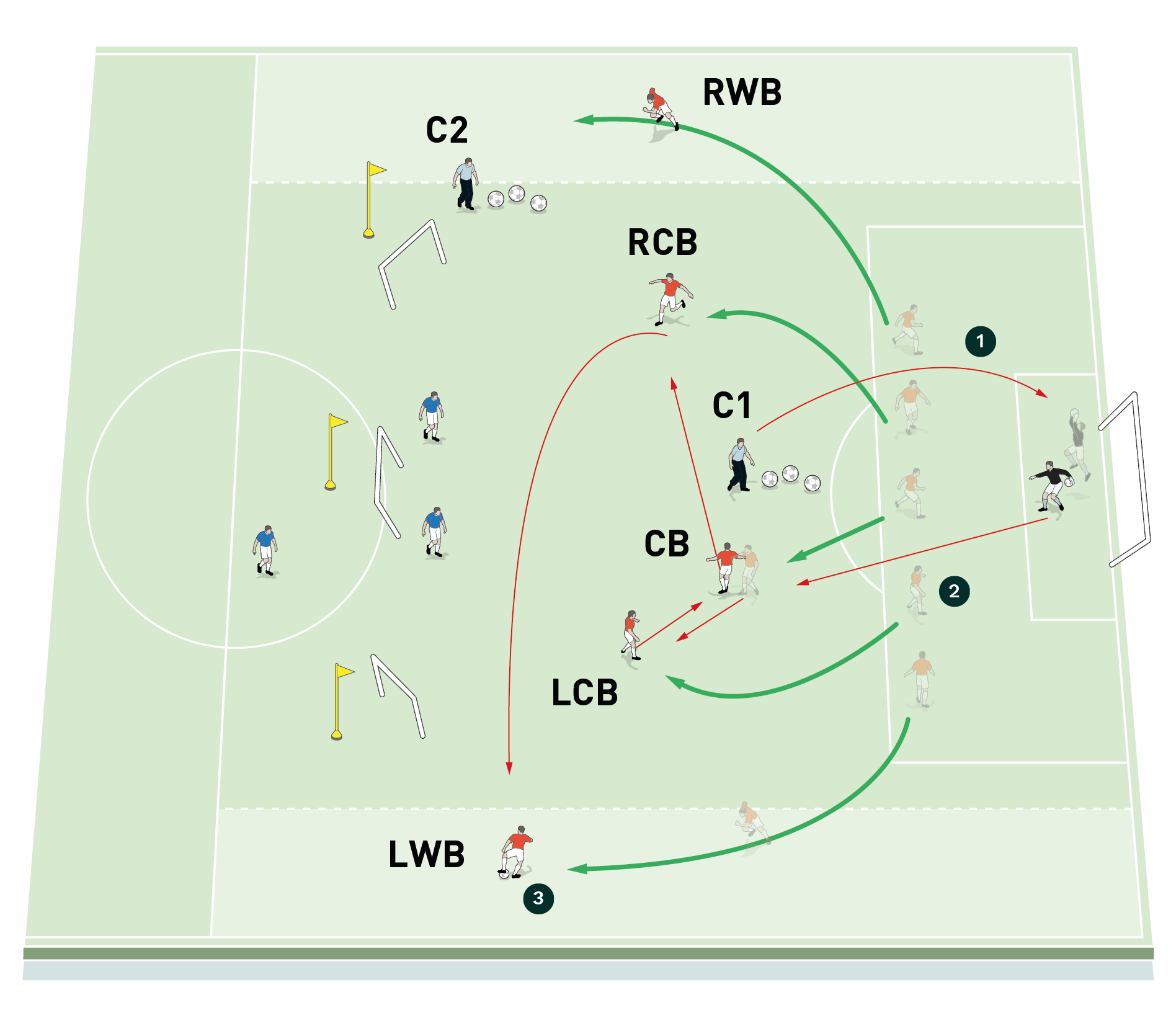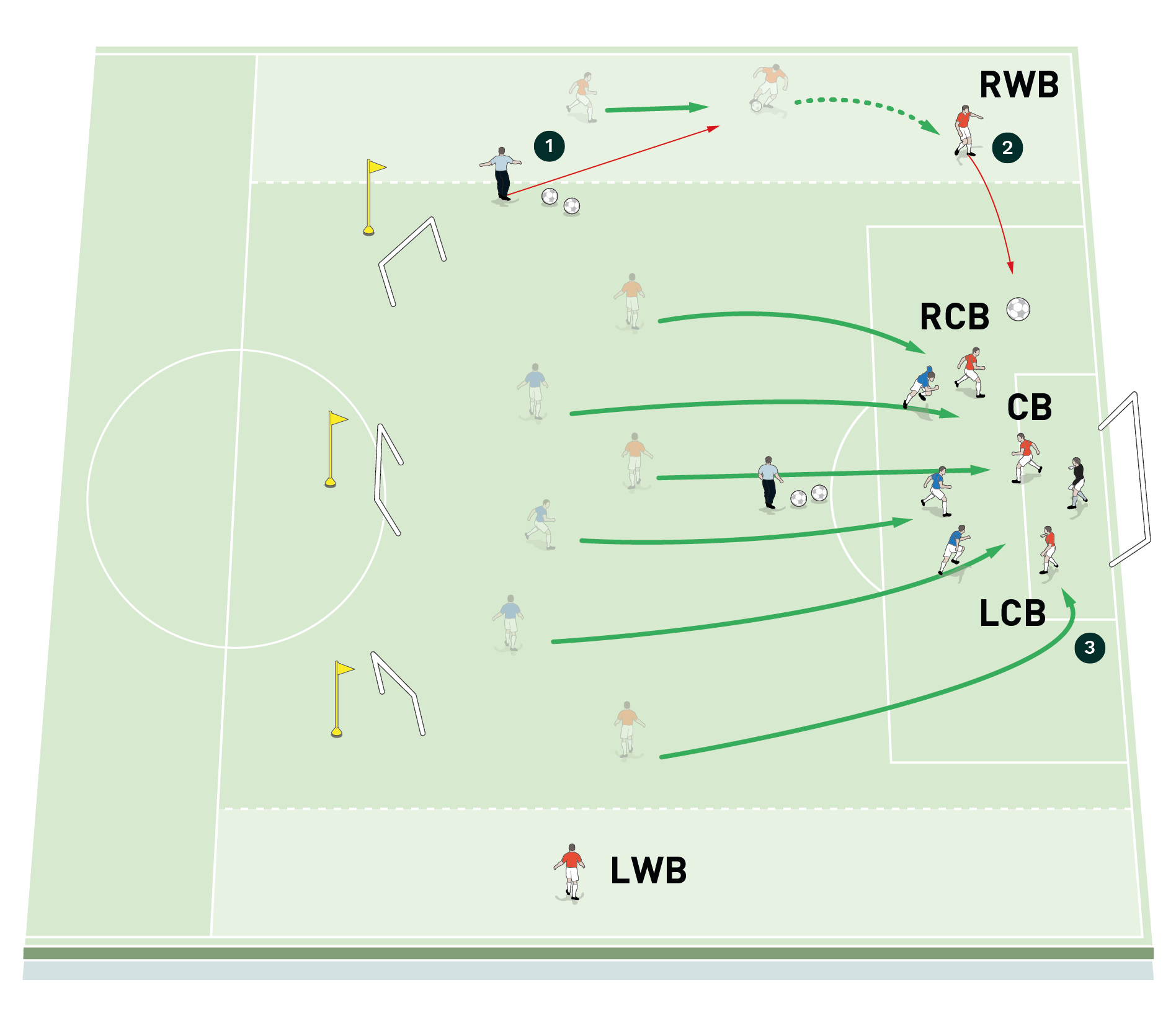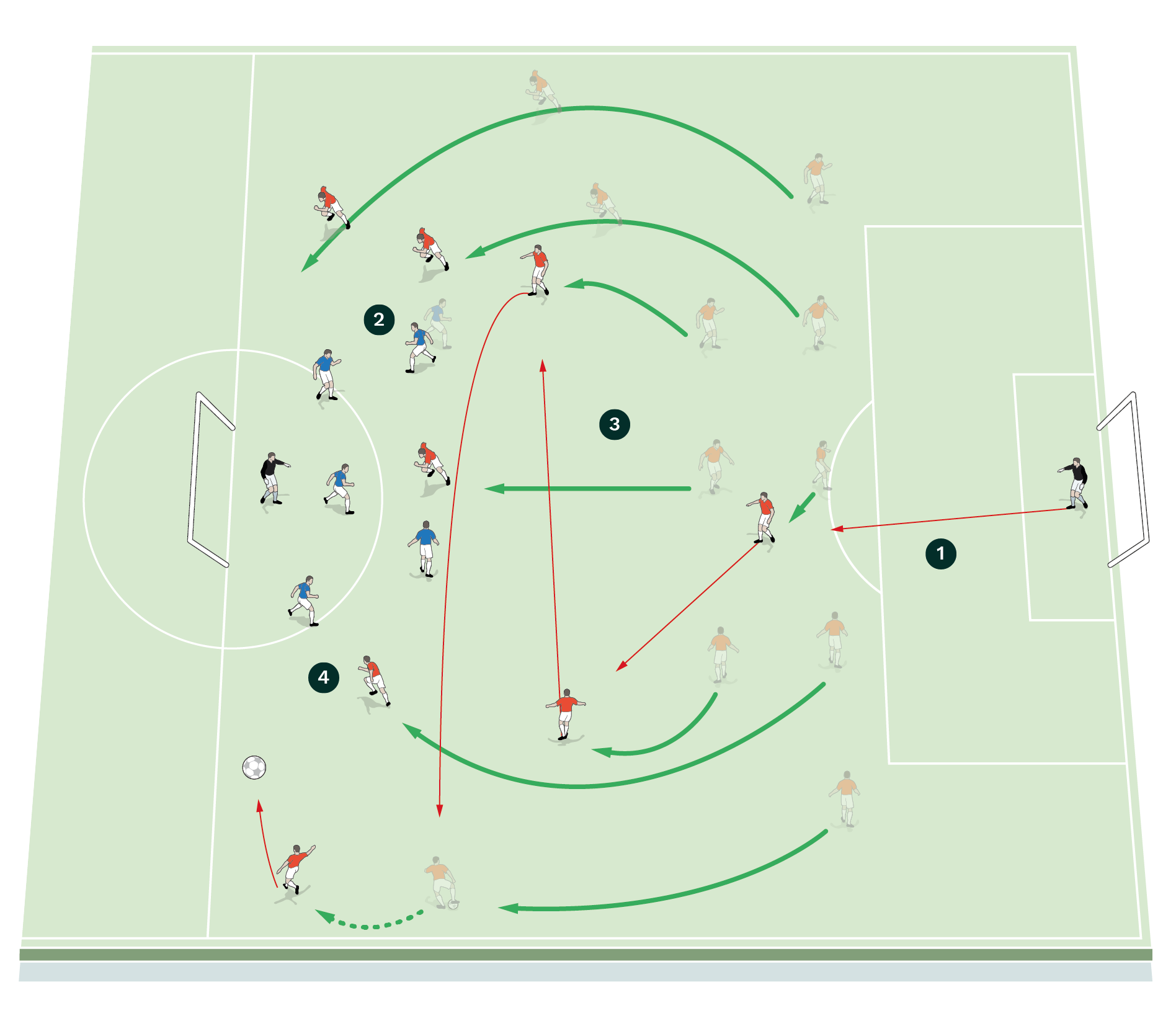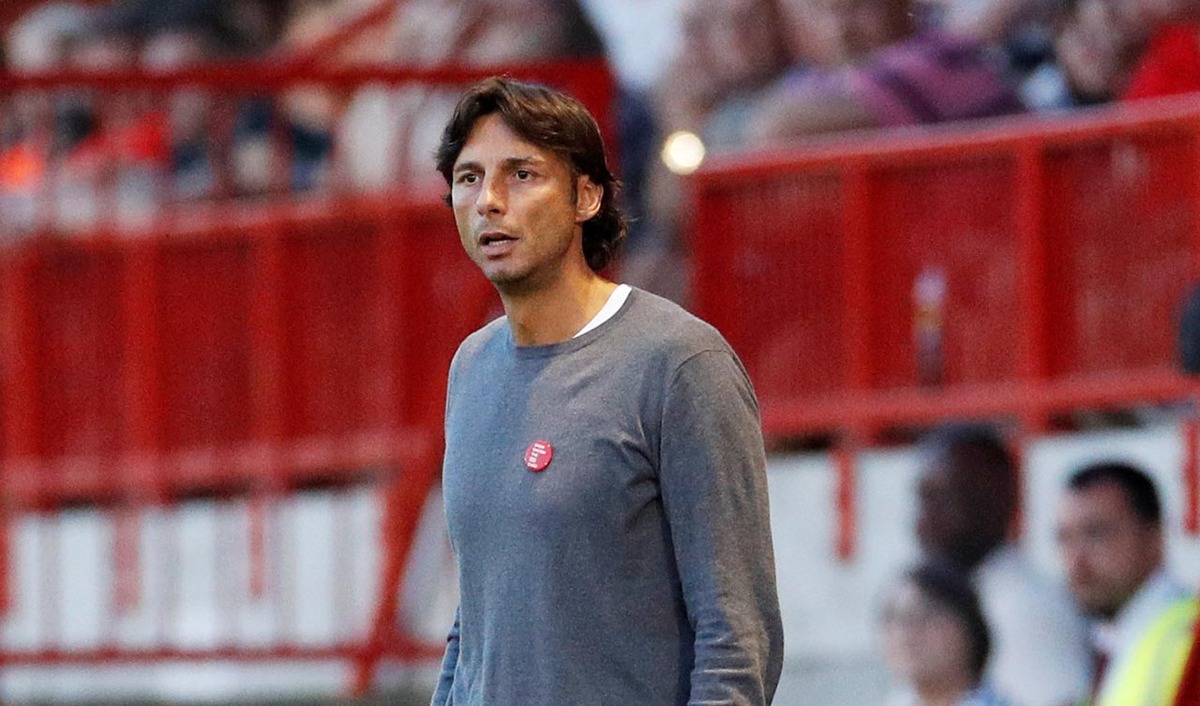




OUR BEST EVER OFFER - SAVE £100/$100
JOIN THE WORLD'S LEADING PROFESSIONAL DEVELOPMENT PROGRAMME
- 12 months membership of Elite Soccer
- Print copy of Elite Player & Coach Development
- Print copy of The Training Ground
You are viewing 1 of your 1 free articles
Building up and transition to defend a cross
| Area | Half a pitch |
| Equipment | Balls, bibs, cones, 3 training poles, 3 small goals, 2 full size goals |
| No. of Players | Up to 11 players + 2 goalkeepers |
| Session Time | Building up: 25mins Progression: 20mins |
This session is about how we get our centre backs to build up play against two or three opponents (two strikers, or two strikers and one midfielder) and it helps players to understand what would be needed in the face of opposition pressure. It also teaches players that as soon as they lose the ball, they have to react to defending a cross from the side.
We play with a back three at Udinese. Our main target is to maintain Serie A status but we want to do it playing football, not just fighting or giving only a defensive mindset. We want to instil the confidence of playing a proactive style of football with the understanding that, not being either Barcelona or Manchester City, there is the chance for us to make mistakes so we have to be sharp to react in emergency situations.
We are keen to give to our players as many tools as possible to be able to leave them to manage the unpredictable aspects of the game. We believe that to give players confidence, you have to work, make mistakes, work on those mistakes and practise, sometimes giving them the solution and sometimes letting them find it for themselves.
In a normal week from Sunday to Sunday, we are used to practising this session on a Friday, two days before the game in a low intensity session.
“We believe that to give players confidence, you have to work, make mistakes, work on those mistakes and practise”
BUILDING UP FROM THE DEFENSIVE THIRD
We set up on half a pitch with a goal and a goalkeeper at one end and we position three small goals at the other end, each one in front of a training pole. We mark wide channels on either wing.
We’re using eight outfield players. The blue team is made up of three players, two of whom start by defending the small goals and a third who starts behind the central small goal waiting to be used. The opposing red team comprises of a back five, which is made up of three centre backs and two wing backs. The back five start in a compact line at the edge of the penalty and they are defending the main goal and attacking the small goals.
Play starts with coach 1 throwing a high ball to the red team’s goalkeeper and at the same time the three red centre backs and the two wing backs spread out to the full width of the playing area. As soon as the goalkeeper catches the ball, he passes out to one of the centre backs, who combine with each other. After the centre backs have made a few passes between themselves, they switch the play to one of the wing backs out in the wide channels, as shown [1a].
[1a]

2. After catching the ball, the keeper passes it to one of the centre backs, who combine with each other
3. After some combination play, the red centre backs switch the play to one of the wing backs in the wide channel. When the wing back has the ball under control, that ball is dead
[1b]

2. The three red centre backs must either try to score in the mini goals, or drive past the training poles with the ball
3. The third blue player can join in to stop the second attack if needed, making it a 3v3
[1c]

2. The red wing back drives down the wing and crosses to the three blues, who try to score in the main goal
3. The three red centre backs recover and defend against the attack
When the wing back receives the ball and has it under control, that ball is dead. The coach then plays a second ball to one of the red centre backs and the three of them attack the blue defenders and either try to score in one of the mini goals, as shown [1b], or drive with the ball past the training poles before stopping with the ball. The third blue defender can join in to stop the second attack if needed to make it a 3v3.
The moment the second attack is dead, coach 2 plays a third ball to the red wing back that didn’t receive the ball in the first attack. The red wing back is now supporting a blue attack and drives down the wing, crossing into the penalty area for the three blues who try to score in the main goal, as shown [1c]. The three red centre backs must recover in a bottleneck and defend against the attack.
PROGRESSION
We now remove the mini goals and the training poles and set up on half a pitch with a full size goal at each end and we play a game. We add another goalkeeper and a second full size goal. As a first progression we add a playmaker to the red team’s back five and an additional player to the blue team and we ask the blues to emulate the playing style of our next opponents. As a second progression we complete the red midfield by adding two midfielders and we also add another player to the blue team.
Play starts and restarts from the red team’s keeper. The red team should use the principles they learnt in the first activity and should begin each attack from a position of compactness (both the defence and the midfield) and then they spread out, as shown [2].
[2]

2. Add a pair of players to the blue team, who should emulate the style of the next opponents
3. Add two midfielders and a playmaker to the red team and play a game using the principles the players learnt in the first activity
4. The reds should begin each attack from a position of compactness and then spread out
COACHING POINTS
What are the key things to look for?
When in possession of the ball, we want to see players starting from a position where they are close to each other in a compact shape. Then, as they build through the defensive third, they should spread out and cover the full width of the pitch.
We want to see accuracy and quality from players when we stretch the play. We also want to see the ball carrier driving into space if there is no pressure on him at the time.
If we play against a team where the stretch of play is not effective, we put the focus on a fast shifting of the ball and on driving forwards to make the opponents react.
Off the ball, we want to see bottleneck recovery runs from the three centre backs to defend, with the first centre backs on the near post, and the other two in the middle and on the far post.
What are the typical mistakes players might make and how do I avoid them?
Often the centre backs don’t recognise when to drive on and when to play forwards, while sometimes the wing backs don’t exploit the full width of the pitch and they don’t keep up with play properly. When the ball is played to one wing back, after a shift of play the opposite wing back is often still open when we would like him tucked in.
Another common mistake occurs when the centre backs are off the ball – they look at the ball, losing the opponent’s position.
Related Files
Editor's Picks
Attacking transitions
Deep runs in the final third
Using the goalkeeper in build-up play
Intensive boxes drill with goals
Penetrating the final third
Creating and finishing
My philosophy
Pressing initiation
Compact team movement
Coaches' Testimonials

Alan Pardew

Arsène Wenger

Brendan Rodgers

Carlos Carvalhal

José Mourinho

Jürgen Klopp

Pep Guardiola

Roy Hodgson

Sir Alex Ferguson

Steven Gerrard
Related
Coaches' Testimonials

Gerald Kearney, Downtown Las Vegas Soccer Club

Paul Butler, Florida, USA

Rick Shields, Springboro, USA

Tony Green, Pierrefonds Titans, Quebec, Canada
Join the world's leading coaches and managers and discover for yourself one of the best kept secrets in coaching. No other training tool on the planet is written or read by the calibre of names you’ll find in Elite Soccer.
In a recent survey 92% of subscribers said Elite Soccer makes them more confident, 89% said it makes them a more effective coach and 91% said it makes them more inspired.
Get Monthly Inspiration
All the latest techniques and approaches
Since 2010 Elite Soccer has given subscribers exclusive insight into the training ground practices of the world’s best coaches. Published in partnership with the League Managers Association we have unparalleled access to the leading lights in the English leagues, as well as a host of international managers.
Elite Soccer exclusively features sessions written by the coaches themselves. There are no observed sessions and no sessions “in the style of”, just first-hand advice delivered direct to you from the coach.







